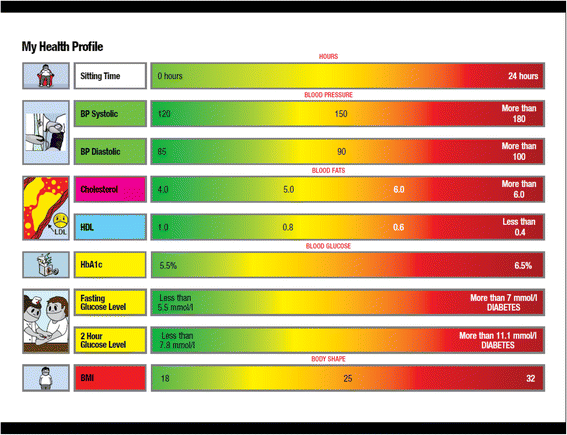Reducing sedentary time in adults at risk of type 2 diabetes: process evaluation of the STAND (Sedentary Time ANd Diabetes) RCT
- PMID: 28088243
- PMCID: PMC5237565
- DOI: 10.1186/s12889-016-3941-9
Reducing sedentary time in adults at risk of type 2 diabetes: process evaluation of the STAND (Sedentary Time ANd Diabetes) RCT
Abstract
Background: Reducing sedentary behaviour may have important health implications. This study evaluated the potential enablers and barriers for outcomes of a randomised controlled trial (RCT) designed to evaluate a pragmatic education based intervention designed to reduce sedentary (sitting) behaviour in young adults at high risk of type 2 diabetes.
Methods: Data were collected from participants in the intervention group immediately after an educational workshop addressing sedentary time and diabetes risk (n = 71), through phone interviews 6 weeks (n = 45) after the workshop, and at the conclusion of the 12-month trial (n = 10). The two education session facilitators were also interviewed about the intervention.
Results: The RCT showed no difference in sedentary time at 12 months between intervention and control arms. The lack of behaviour change appeared not to be attributed to the workshops, which were well led and very favourably received according to feedback. However, factors contributing to this lack of behaviour change include lack of perceived health risk from baseline measures feedback; the preference to adopt physically active behaviours rather than to sit less; certain barriers to sitting less; motivational drift after the 3-month follow-up measurements where participants had no contact for a further 9 months; and, for some, unreliability of the self-monitoring tool.
Conclusions: The workshop was well led and well received by the attendees but future interventions need to consider more contact with participants, discuss any specific benefits around simply standing to reduce sitting time, address the barriers to sitting less, and provide a more user-friendly and reliable self-monitoring tool.
Trial registration: Current controlled trials ISRCTN08434554 , MRC project 91409. Registered retrospectively on 22 February 2011.
Figures
Similar articles
-
Interventions outside the workplace for reducing sedentary behaviour in adults under 60 years of age.Cochrane Database Syst Rev. 2020 Jul 17;7(7):CD012554. doi: 10.1002/14651858.CD012554.pub2. Cochrane Database Syst Rev. 2020. PMID: 32678471 Free PMC article.
-
A Randomised Controlled Trial to Reduce Sedentary Time in Young Adults at Risk of Type 2 Diabetes Mellitus: Project STAND (Sedentary Time ANd Diabetes).PLoS One. 2015 Dec 1;10(12):e0143398. doi: 10.1371/journal.pone.0143398. eCollection 2015. PLoS One. 2015. PMID: 26623654 Free PMC article. Clinical Trial.
-
Rationale and study design for a randomised controlled trial to reduce sedentary time in adults at risk of type 2 diabetes mellitus: project stand (Sedentary Time ANd diabetes).BMC Public Health. 2011 Dec 8;11:908. doi: 10.1186/1471-2458-11-908. BMC Public Health. 2011. PMID: 22151909 Free PMC article. Clinical Trial.
-
Stand More AT Work (SMArT Work): using the behaviour change wheel to develop an intervention to reduce sitting time in the workplace.BMC Public Health. 2018 Mar 6;18(1):319. doi: 10.1186/s12889-018-5187-1. BMC Public Health. 2018. PMID: 29510715 Free PMC article. Clinical Trial.
-
Interventions for reducing sedentary behaviour in community-dwelling older adults.Cochrane Database Syst Rev. 2021 Jun 25;6(6):CD012784. doi: 10.1002/14651858.CD012784.pub2. Cochrane Database Syst Rev. 2021. PMID: 34169503 Free PMC article.
Cited by
-
Exploring adults' experiences of sedentary behaviour and participation in non-workplace interventions designed to reduce sedentary behaviour: a thematic synthesis of qualitative studies.BMC Public Health. 2019 Aug 13;19(1):1099. doi: 10.1186/s12889-019-7365-1. BMC Public Health. 2019. PMID: 31409324 Free PMC article. Review.
-
Interventions outside the workplace for reducing sedentary behaviour in adults under 60 years of age.Cochrane Database Syst Rev. 2020 Jul 17;7(7):CD012554. doi: 10.1002/14651858.CD012554.pub2. Cochrane Database Syst Rev. 2020. PMID: 32678471 Free PMC article.
-
A-REST (Activity to Reduce Excessive Sitting Time): A Feasibility Trial to Reduce Prolonged Sitting in Police Staff.Int J Environ Res Public Health. 2022 Jul 27;19(15):9186. doi: 10.3390/ijerph19159186. Int J Environ Res Public Health. 2022. PMID: 35954543 Free PMC article.
-
Understanding implementation success: protocol for an in-depth, mixed-methods process evaluation of a cluster randomised controlled trial testing methods to improve detection of Lynch syndrome in Australian hospitals.BMJ Open. 2020 Jun 15;10(6):e033552. doi: 10.1136/bmjopen-2019-033552. BMJ Open. 2020. PMID: 32540886 Free PMC article.
-
Impact of yoga on the central and peripheral vascular function among desk-based workers: A single-centered trial study.F1000Res. 2025 Jun 16;13:277. doi: 10.12688/f1000research.135239.4. eCollection 2024. F1000Res. 2025. PMID: 40626092 Free PMC article.
References
-
- Wilmot EG, Edwardson CL, Achana FA, Davies MJ, Gorely T, Gray LJ, Khunti K, Yates T, Biddle SJH. Sedentary time in adults and the association with diabetes, cardiovascular disease and death: systematic review and meta-analysis. Diabetologia. 2012;55(11):2895–905. doi: 10.1007/s00125-012-2677-z. - DOI - PubMed
-
- Petersen CB, Bauman A, Tolstrup JS. Total sitting time and the risk of incident diabetes in Danish adults (the DANHES cohort) over 5 years: a prospective study. Brit J Sport Med. 2016. - PubMed
Publication types
MeSH terms
Associated data
Grants and funding
LinkOut - more resources
Full Text Sources
Other Literature Sources
Medical


